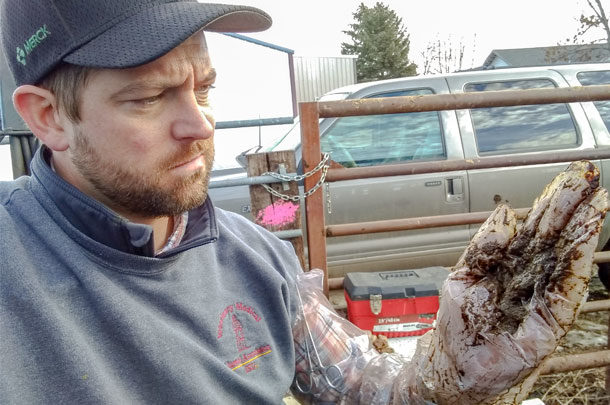Take calf scours for instance. If you’ve ever called your vet about a scouring calf, you probably have described the consistency, odor and color of the manure in detail. The rest of America does this when talking about their food, but unfortunately our topic doesn’t get as many likes on Instagram.
Rather than recoil from the elaborate poop description, your vet probably asked for a color clarification. Was it yellow, or more of a greyish-yellow? Were there any streaks of red or little dabs of black present? This isn’t due to some weird fecal fetish, but rather it is an attempt to uncover the most likely bug causing your calf’s ailment. Of course, these questions require you to stare intently at your calf’s backside and most likely elevate the tail to really get a good look. Maybe you open the barn door or turn the calf toward the sunlight to get a solid confirmation on the hue of the liquid in question.
Really, someone should put together some color swatches like they have for the paints down at the hardware store that you can hold next to the scoured-up tail. Rather than just listing the pathogen with the color though, it should have the same funky types of names they give all the different paints. “Elegant E. coli” and “calypso crypto” have a much nicer ring to them anyway.
At this point in our discussion, I have a confession to make that will make a person question my veterinary abilities. I am colorblind. When it comes to this game of ruling out scours causes based on colors, I’m hopelessly lost. Heck, when I sleeve a cow, I have to ask the person who brought her in if there’s blood in the stool or not. You can imagine the hundreds of funny looks I’ve gotten from people wondering why the vet wants their opinion on their sick cow’s manure composition.
These color challenges expand beyond fecal material. Differentiating between multiple types of bacteria requires staining them on a microscope slide or picking out a certain colored colony on a culture plate. For the life of me, I’ve never been able to tell them apart. Thanks to the A-plus techs I work with, the answers can be determined with certainty. How I got through those labs in vet school must have been the work of the Lord.
The good news for me is that while colors are important in veterinary medicine, they are irrelevant in preg checking, replacing a prolapse or working through a wreck in a pen of cattle. As long as I can do that and have good co-workers to bail me out when the hue of the stool matters, I’m good to go. ![]()
Jacob Geis is a veterinarian and blogger in Freeman, South Dakota.
PHOTO: Agriculture is one of those few professions where it is normal for a person to take a good, hard look at the color of manure. Photo provided by Jacob Geis.











